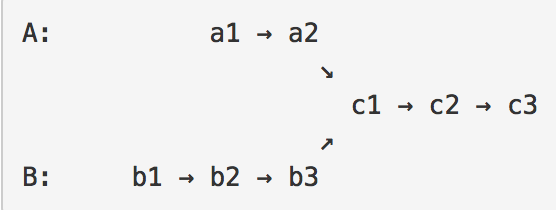问题:
Write a program to find the node at which the intersection of two singly linked lists begins.
For example, the following two linked lists:

begin to intersect at node c1.Notes:
- If the two linked lists have no intersection at all, return null.
- The linked lists must retain their original structure after the function returns.
- You may assume there are no cycles anywhere in the entire linked structure.
- Your code should preferably run in O(n) time and use only O(1) memory.
大意:
写一个函数来寻找两个单链表开始交汇的节点。
比如,下面这两个链表:

从节点 c1 开始交汇注意:
- 如果两个链表完全不交汇,返回 null。
- 函数返回后原链表必须保持初始结构。
- 你可以假设整个链表结构都没有任何循环。
- 你的代码应该在O(n)的时间和O(1)的内存中完成。
思路:
题目的难点在于在O(n)的时间内完成这个事情,那么普通地遍历去比对就不合适了,因为完全不知道链表会在哪个节点开始交汇,而且这个节点在两个链表中的位置也不一定是一样的,所以这里我利用堆栈。
首先遍历两个链表将其中的节点都放入两个栈中,利用栈后进先出的特性来取节点。因为两个链表如果有交汇,后面的节点一定都是一样的,所以两个栈同时取节点进行比对,当出现不同节点时就表示上一个节点时交汇点。
注意“==”这个等号表示比对两个对象的引用是否相等。
代码(Java):
/**
* Definition for singly-linked list.
* public class ListNode {
* int val;
* ListNode next;
* ListNode(int x) {
* val = x;
* next = null;
* }
* }
*/
public class Solution {
public ListNode getIntersectionNode(ListNode headA, ListNode headB) {
boolean hasFind = false;
ListNode a = headA;
ListNode b = headB;
Stack<ListNode> stackA = new Stack<ListNode>();
Stack<ListNode> stackB = new Stack<ListNode>();
while (a != null) {
stackA.push(a);
a = a.next;
}
while (b != null) {
stackB.push(b);
b = b.next;
}
if (stackA.empty() || stackB.empty()) return null;
ListNode result = null;
while (!(stackA.empty() || stackB.empty())) {
if (stackA.peek() == stackB.peek()) {
result = stackA.peek();
stackA.pop();
stackB.pop();
} else {
return result;
}
}
return result;
}
}他山之石:
/**
* Definition for singly-linked list.
* public class ListNode {
* int val;
* ListNode next;
* ListNode(int x) {
* val = x;
* next = null;
* }
* }
*/
public class Solution {
public ListNode getIntersectionNode(ListNode headA, ListNode headB) {
//boundary check
if(headA == null || headB == null) return null;
ListNode a = headA;
ListNode b = headB;
//if a & b have different len, then we will stop the loop after second iteration
while( a != b){
//for the end of first iteration, we just reset the pointer to the head of another linkedlist
a = a == null? headB : a.next;
b = b == null? headA : b.next;
}
return a;
}
}这个做法很巧妙的地方在于其循环体的内容,每轮循环都将两个链表的标记往后移动一个,当移动到末尾后就跳到另一个链表头再移动,循环的结束条件是两个标记相同。什么情况下会相同呢?两种情况,一是遇到了相同节点,另一个是完全没有相同节点,由于都会遍历一次两个链表,所以会在同时到达null,如果两个链表长度一直,那么不用跳,直接遍历一次没有交汇就都同时到null了。如果有交汇的,那一定是第一个交汇点。
合集:https://github.com/Cloudox/LeetCode-Record
版权所有:http://blog.csdn.net/cloudox_
























 367
367

 被折叠的 条评论
为什么被折叠?
被折叠的 条评论
为什么被折叠?








